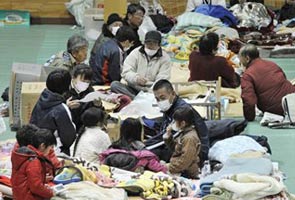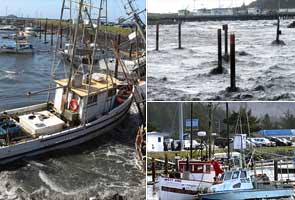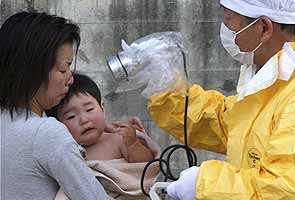Tokyo: Japan's nuclear crisis verged toward catastrophe on Tuesday, after an explosion at one crippled reactor damaged its crucial steel containment structure and a fire at another reactor spewed large amounts of radioactive material into the air, according to official statements and industry executives informed about the developments.
After an emergency Cabinet meeting, the Japanese government told people living within 30 kilometers, about 18 miles, of the Fukushima Daiichi Nuclear Power Station to stay indoors, keep their windows closed and stop using air-conditioning.
Officials said emergency efforts to pump seawater into three stricken reactors at the plant were continuing, but that most of the 800 workers at the Daiichi facility had been told to leave to avoid exposure to unhealthy levels of radiation at the plant. They said 50 workers would remain at the plant to pump seawater into three reactors and fight the fire at the fourth reactor.
Japan's nuclear safety watchdog later said that the fire at the No. 4 reactor had been extinguished, The Associated Press reported.
Prime Minister Naoto Kan briefly addressed the nation on television at 11 am, pleading for calm as engineers struggled to bring the damaged reactors under control.
Mr. Kan said that radiation had spread from the crippled reactors and there was "a very high risk" of further leakages.
"I would like to ask the nation, although this incident is of great concern, I ask you to react very calmly," Mr. Kan said.
The cascade of problems at Daiichi was initially difficult to interpret - with confusion compounded by incomplete and inconsistent information provided by government officials and executives of the plant's operator, Tokyo Electric Power.
But industry executives in close contact with officials in Japan said that the chain of events at Daiichi suggested that the authorities had come close to losing control of the situation, and that it would be difficult to maintain emergency seawater cooling operations at stricken reactors if a fire at a fourth reactor nearby was releasing large amounts of radioactive material - at least without threatening the health of emergency workers onsite.
The problem at the fourth reactor had not been reported before late Tuesday morning. According to officials, a fire broke out at that reactor, which had been offline at the time of the earthquake but was storing spent nuclear fuel.
"No. 4 is currently burning, and we assume radiation is being released. We are trying to put out the fire and cool down the reactor," the chief government spokesman, Yukio Edano, said at a televised press conference. "There were no fuel rods in the reactor, but spent fuel rods are inside."
Spent fuel rods, depending on their age, can still emit large amounts of radioactive material and need to remain immersed in cool water. Even so, and despite the fact that the No. 4 reactor was emitting large amounts of radioactive material, Mr. Edano said the reactor "did not pose an imminent threat."
The sharp deterioration came after a frantic day and night of rescue efforts focused largely on the No. 2 reactor. There, a malfunctioning valve prevented workers from manually venting the containment vessel to release pressure and allow fresh seawater to be injected into it. That meant that the extraordinary remedy emergency workers had been using to keep the nuclear fuel from overheating no longer worked.
As a result, the nuclear fuel in that reactor was exposed for many hours, increasing the risk of a breach of the container vessel and more dangerous emissions of radioactive particles.
By Tuesday morning, Tokyo Electric Power said that it had fixed the valve and resumed seawater injections, but that possible leaks were detected in the containment vessel that prevented water from fully covering the fuel rods.
Then an explosion hit that reactor. After a series of conflicting reports about what level of damage was inflicted on the reactor after that blast, Mr. Edano said, "There is a very high probability that a portion of the container vessel was damaged."
The steel container vessels that protect nuclear fuel in reactors are considered crucial to maintain the integrity of the reactor and the safety of the fuel, and any breach of the container risks a much larger release of radioactive material that what has occurred to date fro the Japanese plant, industry executives said.
Mr. Edano, however, said that the level of leaking at the No. 2 reactor was still small, raising the prospect that the container was sufficiently intact to protect the nuclear fuel inside.
Some outside industry executives were skeptical of official Japanese accounts of what was happening at Daiichi. One executive with extensive contacts among Japanese nuclear industry and government officials said the situation had in fact spiraled out of control and that all plant workers would almost certainly need to leave the plant to avoid excessive exposure to radioactive leaks.
If all workers do in fact leave the plant, the nuclear fuel in all three reactors is likely to meltdown, which would lead to wholesale releases of radioactive material - by far the largest accident of its kind since the Chernobyl disaster 25 years ago.
Even if a full meltdown is averted, Japanese officials have been facing unpalatable options. One was to continue flooding the reactors and venting the resulting steam, while hoping that the prevailing winds, which have headed across the Pacific, did not turn south toward Tokyo or west, across northern Japan to the Korean Peninsula. The other was to hope that the worst of the overheating was over, and that with the passage of a few more days the nuclear cores would cool enough to essentially entomb the radioactivity inside the plants, which clearly will never be used again. Both approaches carried huge risks.
While Japanese officials made no comparisons to past accidents, the release of an unknown quantity of radioactive gases and particles - all signs that the reactor cores were damaged from at least partial melting of fuel - added considerable tension to the effort to cool the reactors.
"It's way past Three Mile Island already," said Frank von Hippel, a physicist and professor at Princeton. "The biggest risk now is that the core really melts down and you have a steam explosion."
One continuing concern made more acute by the fire at the No. 4 reactor is the fate of spent nuclear fuel being stored at the Daiichi plant. Tokyo Electric said Monday that it had not been able to keep containment pools holding spent fuel properly cooled during the crisis because their attention and resources were devoted to keep the active fuel rods in the reactors from melting down after cooling system malfunctioned.
"Tokyo Electric has not been able to cool" the spent fuel pools at its two troubled nuclear plants, Daiichi and Daini, because power has been knocked out, said Johei Shiomi, a spokesman for the company. "There may be some heating up," he said.
He also said water had spilled out from the pools, which lie close to the main reactors.
Spent fuel can be as dangerous as active fuel if left uncovered for too long, experts say, though time-to-boil depends on how much fuel is present, and how old it is.
Still, Mr. Shiomi said that the company felt that there "was relatively little danger that temperatures would rise," Mr. Shiomi said. "If you compare this to everything that's been going on, it's not serious," he said. He made those comments before fire broke out at the No. 4 reactor.
Adding to the complexity of the situation was that reactor No. 3 reactor uses a special mix of nuclear fuel known as MOX fuel. MOX is considered contentious because it is made with reprocessed plutonium and uranium oxides. Any radioactive plume from that fuel would be more dangerous than ordinary nuclear fuel, experts say, because inhaling plutonium even in very small quantities is considered lethal.






 Click to Expand & Play
Click to Expand & Play